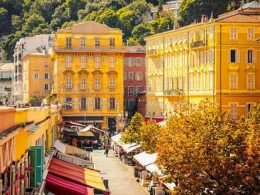‘Discovering French Cuisine: A Regional Guide’ provides a comprehensive exploration of the diverse culinary traditions found throughout France.
This guide offers a detailed look into the unique flavors and ingredients that define the gastronomic heritage of different regions, including Normandy, Provence, Alsace, and Lyon/Rhône Valley.
From the rich and creamy dishes of Normandy to the vibrant and aromatic cuisine of Provence, this guide illuminates the distinct characteristics of each region’s culinary offerings.
Whether you are a culinary enthusiast, a traveler seeking authentic dining experiences, or a professional chef looking to expand your repertoire, ‘Discovering French Cuisine: A Regional Guide’ serves as an invaluable resource for understanding and appreciating the rich tapestry of French gastronomy.
The Flavors of Normandy
The flavors of Normandy offer a rich tapestry of culinary delights, drawing from the region’s bountiful coastal and agricultural resources. Normandy’s culinary heritage is deeply rooted in its proximity to the sea and lush countryside, resulting in a diverse array of traditional dishes that reflect the area’s natural abundance.
One such renowned dish is the creamy Normandy Camembert, a soft, ripened cheese with a distinct earthy flavor. Additionally, Normandy is celebrated for its delectable apple-based creations, including the famous Tarte Tatin and the refreshing apple cider.
Seafood also features prominently in Normandy’s gastronomy, with dishes like Moules Marinières (mussels in white wine) and Sole Meunière (sole fish in butter sauce) showcasing the region’s mastery of coastal cuisine.
Normandy’s culinary offerings truly epitomize the marriage of land and sea, delivering an unforgettable dining experience.
Provence: A Taste of the Mediterranean
An exploration of Provence reveals a vibrant tapestry of Mediterranean flavors that captivate the senses with their aromatic herbs, sun-ripened produce, and seafood delicacies.
Influenced by the bountiful Mediterranean region, traditional Provençal dishes boast a rich tapestry of flavors and ingredients. The cuisine of Provence is characterized by the abundant use of olive oil, garlic, and an array of herbs such as thyme, rosemary, and oregano, reflecting the Mediterranean influences that define the region.
Provence’s coastal location also infuses its culinary traditions with an abundance of fresh seafood, giving rise to exquisite dishes like bouillabaisse, a traditional Provençal fish stew.
Additionally, the region’s sun-kissed fruits and vegetables, including tomatoes, eggplants, and peppers, form the foundation of many iconic Provençal recipes, showcasing the region’s deep-rooted connection to the Mediterranean terroir.
Exploring the Culinary Traditions of Alsace
Exploring Alsace’s culinary traditions uncovers a fusion of German and French influences, resulting in a unique gastronomic experience.
Alsatian specialties, such as choucroute (sauerkraut with sausages and other salted meats), baeckeoffe (a slow-cooked casserole of meats and potatoes), and tarte flambée (a thin-crusted pizza-like dish), showcase the region’s rich culinary heritage.
The influence of German cuisine is evident in the hearty dishes and the use of unique ingredients such as sauerkraut, smoked meats, and strong-flavored cheeses like Munster and Géromé.
Traditional recipes handed down through generations reflect the region’s blend of French elegance and German robustness, creating a diverse and flavorful culinary tapestry.
Whether exploring bustling markets or cozy local restaurants, visitors to Alsace are sure to delight in the region’s distinctive and delicious food offerings.
Savory Delights of Lyon and the Rhône Valley
Sitting at the crossroads of French and German culinary influences, the Savory Delights of Lyon and the Rhône Valley offer a rich tapestry of flavors and traditions that build upon the regional fusion of Alsace. When exploring this region, two culinary aspects stand out:
- Lyon’s Bouchon Culture: Lyon is renowned for its traditional bouchons, cozy restaurants serving hearty, home-style cuisine. These establishments offer classic Lyonnaise dishes such as quenelles, coq au vin, andouillette sausages, and the iconic salad Lyonnaise. The convivial atmosphere and emphasis on locally sourced ingredients make dining at a bouchon an authentic and delightful experience.
- Rhône Valley Wines: The Rhône Valley is celebrated for producing a diverse array of wines, ranging from full-bodied reds like Côtes du Rhône and Hermitage to elegant whites such as Condrieu and Châteauneuf-du-Pape. These wines perfectly complement the rich and varied flavors of the local cuisine.
Frequently Asked Questions
What Are the Typical Ingredients Used in Normandy Cuisine?
Typical ingredients in Normandy cuisine include seafood such as oysters, mussels, and fish, as well as dairy products like butter and cream. The region’s culinary influences reflect its coastal location and agricultural traditions.
Is There a Specific Dish That Represents the Essence of Provencal Cuisine?
The essence of Provencal cuisine is encapsulated in its iconic dish, ratatouille. This flavorful stew of seasonal vegetables showcases the authentic Provencal flavors and culinary heritage. It is enriched with Provencal herbs, reflecting the region’s rich gastronomic tradition.
How Do the Culinary Traditions of Alsace Differ From Other Regions in France?
The culinary traditions of Alsace differ from other regions in France due to its unique blend of German and French influences. These influences are reflected in the region’s cuisine, particularly in their wine pairings, which often include Riesling and Gewürztraminer.
What Are Some Popular Traditional Dishes From Lyon and the Rhône Valley?
Lyon’s bouchon culture is known for traditional dishes like coq au vin and quenelles. The Rhône Valley is famous for its wines, such as Côtes du Rhône and Hermitage. Both regions offer a rich culinary experience rooted in tradition.
Are There Any Unique Cooking Techniques or Utensils Used in These Regional Cuisines?
French cooking techniques and regional culinary practices often involve unique cooking methods and traditional utensils. In Lyon and the Rhône Valley, you may find techniques like braising and unique utensils such as copper pots and pans.










